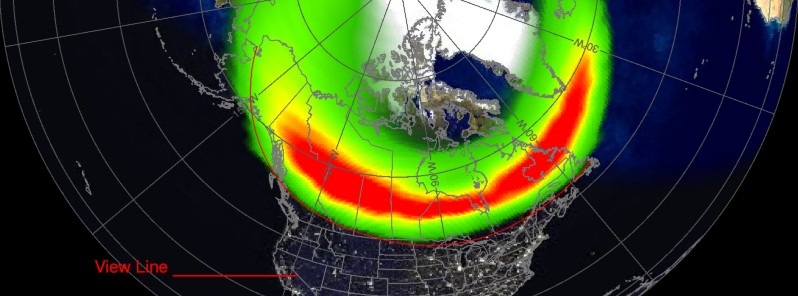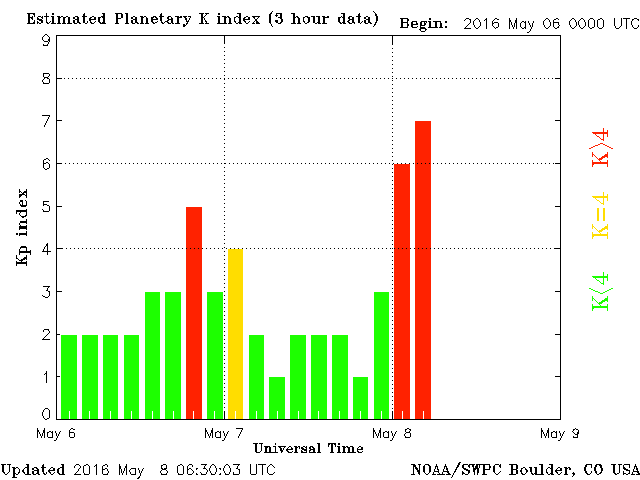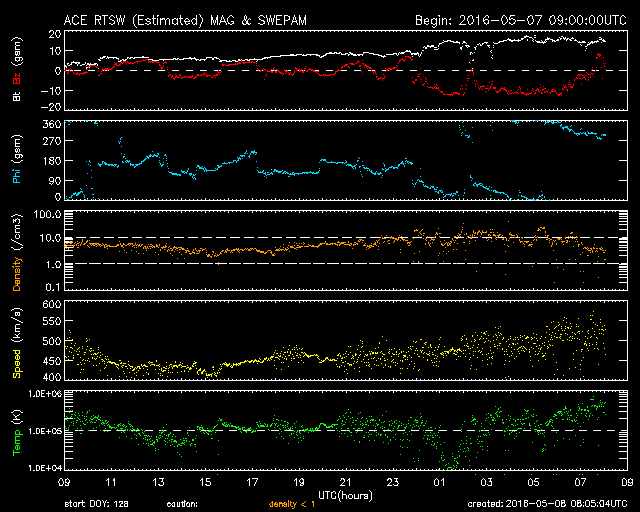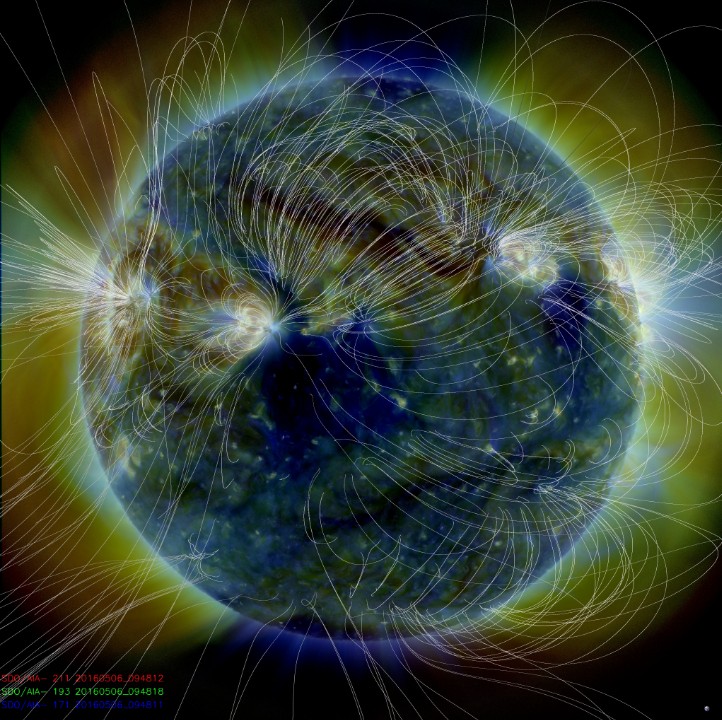Strong geomagnetic storms in progress

A G3 – Strong geomagnetic storm conditions were observed beginning 05:59 UTC on May 8, 2016. G2 – Moderate to G3 – Strong geomagnetic storm conditions are expected through the rest of the day and possibly into May 9 and 10. This activity is caused by a recurrent, equatorial, negative polarity coronal hole high speed stream.
Geomagnetic K-index of 5 (G1 – Minor geomagnetic storm) threshold was first reached at 02:25 UTC on May 8. K-index of 6 (G2 – Moderate) threshold was reached just 30 minutes after, at 02:59 UTC. Over the next three hours, conditions further deteriorated and by 05:59 a G3 – Strong geomagnetic storm (K-index of 7) was in progress.
Under G3 – Strong geomagnetic storms, the area of impact is primarily poleward of 50 degrees Geomagnetic Latitude. Power system voltage irregularities are possible, false alarms may be triggered on some protection devices. Spacecraft systems may experience surface charging; increased drag on low Earth-orbit satellites and orientation problems may occur. Intermittent satellite navigation (GPS) problems, including loss-of-lock and increased range error may occur. Radio – HF (high frequency) radio may be intermittent. Aurora may be seen as low as Pennsylvania to Iowa to Oregon
G3 – Strong geomagnetic storm lasted for about 1 hour, until 06:55, when G1 – Minor storm conditions were observed again. This weakening, however, didn't last long.
At 08:07 UTC, observed K-index reached 6 again (G2 – Moderate).



Coronal hole as observed by NASA's SDO (AIA 211/193/171) on May 6, 2016.
It is worth noting that G2 and 3 geomagnetic storms were not expected.
SWPC alerts
Space Weather Message Code: ALTK05
Serial Number: 959
Issue Time: 2016 May 08 0228 UTC
ALERT: Geomagnetic K-index of 5
Threshold Reached: 2016 May 08 0225 UTC
Synoptic Period: 0000-0300 UTC
Active Warning: Yes
NOAA Scale: G1 – Minor
NOAA Space Weather Scale descriptions can be found at
www.swpc.noaa.gov/noaa-scales-explanation
Potential Impacts: Area of impact primarily poleward of 60 degrees Geomagnetic Latitude.
Induced Currents – Weak power grid fluctuations can occur.
Spacecraft – Minor impact on satellite operations possible.
Aurora – Aurora may be visible at high latitudes, i.e., northern tier of the U.S. such as northern Michigan and Maine.
***
Space Weather Message Code: ALTK06
Serial Number: 401
Issue Time: 2016 May 08 0303 UTC
ALERT: Geomagnetic K-index of 6
Threshold Reached: 2016 May 08 0259 UTC
Synoptic Period: 0000-0300 UTC
Active Warning: Yes
NOAA Scale: G2 – Moderate
NOAA Space Weather Scale descriptions can be found at
www.swpc.noaa.gov/noaa-scales-explanation
Potential Impacts: Area of impact primarily poleward of 55 degrees Geomagnetic Latitude.
Induced Currents – Power grid fluctuations can occur. High-latitude power systems may experience voltage alarms.
Spacecraft – Satellite orientation irregularities may occur; increased drag on low Earth-orbit satellites is possible.
Radio – HF (high frequency) radio propagation can fade at higher latitudes.
Aurora – Aurora may be seen as low as New York to Wisconsin to Washington state.
***
Space Weather Message Code: ALTK07
Serial Number: 102
Issue Time: 2016 May 08 0558 UTC
ALERT: Geomagnetic K-index of 7
Threshold Reached: 2016 May 08 0559 UTC
Synoptic Period: 0300-0600 UTC
Active Warning: Yes
NOAA Scale: G3 – Strong
NOAA Space Weather Scale descriptions can be found at
www.swpc.noaa.gov/noaa-scales-explanation
Potential Impacts: Area of impact primarily poleward of 50 degrees Geomagnetic Latitude.
Induced Currents – Power system voltage irregularities possible, false alarms may be triggered on some protection devices.
Spacecraft – Systems may experience surface charging; increased drag on low Earth-orbit satellites and orientation problems may occur.
Navigation – Intermittent satellite navigation (GPS) problems, including loss-of-lock and increased range error may occur.
Radio – HF (high frequency) radio may be intermittent.
Aurora – Aurora may be seen as low as Pennsylvania to Iowa to Oregon.
Featured image: Probability of visible aurora at 08:05 UTC on May 8, 2016. Credit: NOAA/SWPC

thank you -world needs real information like this